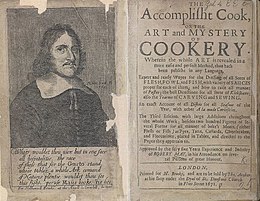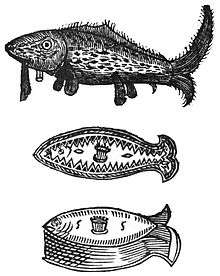The Accomplisht Cook
The Accomplisht Cook is an English cookery book published by the Restoration era professional cook Robert May in 1660, and the first to group recipes logically into sections.
 Frontispiece of 1671 edition | |
| Author | Robert May |
|---|---|
| Country | England |
| Subject | Cookery |
| Publisher | Nathaniel Brooke |
Publication date | 1660 |
| Pages | 300 |
The book made early use of two ingredients brought to Europe from the Americas, the potato and the turkey.
Context
Following the English Civil War, Robert May, the celebrity chef of his time,[1] wrote and published The Accomplisht Cook.[2]
Book
Publication
The work was first published in 1660 by Nathaniel Brooke. The last revision made during the author's lifetime was published in 1665.[3] A (second) edition was published by Nathaniel Brooke in 1671. A third edition was published in 1678 by Obadiah Blagrave.[4] The 1685 edition runs to some 300 pages.[5]
When a 1678 edition of the book was discovered and put up for sale in 2007, the auctioneer Charles Hanson was reported as saying that no more than 200 copies were printed in the 17th century.[6] He added that "May would have been very much the Gordon Ramsay of his day, something of a celebrity chef", asserted that "only 400" copies were printed.[7]
Approach
May's recipes included customs from the Middle Ages, alongside European dishes such as French bisque and Italian brodo (broth),[8] with about 20 percent of the book devoted to soups.[8] May provides a large number of recipes for venison, as for sturgeon, but balances his more elaborate and costly recipes with some for simple dishes.[9]
The recipes are presented entirely as instructions, without lists of ingredients. The instructions are not necessarily in order; he can write "Then have a rost Capon minced", requiring the cook to have already taken, prepared and roasted the capon, a process that takes some hours, in the middle of a recipe (for Olio Podrida). Quantities, if given, are mentioned in passing. Thus he may mention "put them a boiling in a Pipkin of a Gallon", or "the juyce of two or three Oranges", or he may simply say "and put into beaten Butter", leaving the cook to judge the quantity required.[9]
Contents
The book is organised into 24 broad sections, but within these there is sometimes little sign of structure. Thus in Section I, after the elaborate Spanish Olio Podrida there follow four recipes for (bone-)marrow pies to accompany the Olio; then three ways to make a "bisk"; seven ways to boil a chine of veal or mutton; three ways to make barley broth, again involving meat for its "gravy", and so on. If this seems at least to be all about boiling meat, the same section contains "To make several sorts of Puddings", ranging from blood pudding and haggis to sweet rice pudding flavoured with nutmeg, cloves, mace, currants, and dates.
- I: Boiling
- II: Beef
- III: Heads
- IV: Roasting
- V: Sallets
- VI: Frying
- VII: Puddings
- VIII: Souces and Jellies
- IX: Baking
- X: Fruit
- XI: Made Dishes
- XII: Creams
- XIII: Carps
- XIV: Pikes
- XV: Salmon, Bace, or Mullet
- XVI: Turbut, Plaice, Flounders, and Lampry
- XVII: Eels, Conger, Lump, and Soals
- XVIII: Sturgeon
- XIX: Shell-Fish
- XX: Pottages for Fish-Days
- XXI: Eggs
- XXII: Artichocks
- XXIII: Diet for the Sick
- XXIV: Feeding of Poultrey
The book also contains a memoir of the author.[3]
Illustrations

The first edition contained a Frontispiece of the author. The fifth edition of 1685 contained in addition "two hundred Figures of several Forms for all manner of bak’d Meats, (either Flesh, or Fish) as, Pyes Tarts, Custards; Cheesecakes, and Florentines, placed in Tables, and directed to the Pages they appertain to."[10]
Recipes
The following is a recipe in which May used salt cod in a pie:[11]
Being boiled, take it [the salt cod] from its skin and bones, and mince it with some pippins [apples], season it with nutmeg, cinnamon, ginger, pepper, caraway-seed, currans, minced raisons, rose-water, minced lemon peel, sugar, slic't [sliced] dates, white wine, verjuice [sour fruit juice, in this case probably from apples], and butter, fill your pyes, bake them, and ice them.
The following is May's recipe for Lumber Pie:[12]
Take some grated bread, and beef-suet cut into bits like great dice, and some cloves and mace, then some veal or capon minced small with beef suet, sweet herbs, fair sugar, the yolks of six eggs boil'd hard and cut in quarters, put them to the other ingredients, with some barberries, some yolks of raw eggs, and a little cream, work up all together and put it in the caul of veal like little sausages; then bake them in a dish, and being half baked have a pie made and dried in the oven ; put these puddings into it with some butter, verjuyce sugar, some dates on them, large mace, grapes, or barberries, and marrow – being baked, serve it with a cut cover on it, and scrape sugar on it.
Reception
The celebrity cook and author Clarissa Dickson Wright covers The Accomplisht Cook in detail. She notes that few other cookery books were published during the Commonwealth of Oliver Cromwell, and that the book is free of the plagiarism usual at the time. She considers the book therefore to have a "freshness" and to be revealing of well-to-do life in 17th century England, with its many recipes for venison and for fish such as sturgeon and salmon. She is struck that the recipes for birds such as heron include instructions for fattening them after capture, while godwits, knots, grey plovers and curlews were "force-fed in the way that the French force-feed geese today for pâté de foie gras". She notes that May offers "sophisticated and ambitious" recipes alongside simple dishes like porridge and sausages, while the presence of haggis reveals a definite Scottish influence. She notes, too, his openness to foreign recipes, with an "incredibly complicated stew" from Spain, an Olio Podrida containing a rack of mutton, a knuckle of veal, a capon (minced), 12 young pigeons, 8 young chickens, ten sweetbreads, ten palates, and lemons, pomegranates, grapes, saffron and almonds which "presumably .. give the dish its Spanish aspect".[9]
The historian of food Polly Russell, writing in the Financial Times, is struck by the quantity of food May recommends for Christmas, including 20 first courses and 19 second courses. Even the "Grand Sallet" (salad) contained a whole capon and a breast of lamb or veal. Russell sees the lavishness of the book as a reaction to the former dominance of the Puritans over English life.[13]
Vera Rule, writing in The Guardian, argues that May's writing resembled that of his contemporary, the physician William Harvey, communicating exciting facts "through urgent active verbs and imperative terms - leach that brawn, allay that pheasant, unbrace that mallard.[14] She notes that both menus and customs were in transition (from Mediaeval to Early Modern): novelties included tricks like wrapping puddings in a cloth before boiling, whereas May tells readers to place a ring of bits of toast around a stew, so that diners could eat by dipping, rather than make use of new-fangled forks. She comments that his cooking was far from new, though he takes for granted two recent arrivals from the Americas, the potato and the turkey. On the other hand, Rule observes, May was still completely Mediaeval in liking live birds bursting from a fake "pye", complete with mock battle held on the table. Old Byzantine or Middle Eastern cuisine, brought to Europe by Islamic conquerors, similarly features with "saffron, almonds, East Indies spices."[14] She concludes that "His ubiquitous luxury garnish was molten butter frothed with sharp orange juice."[14]
Kate Colquhoun notes that the book was the first to group recipes logically into sections, and that May was the first cook in Britain to illustrate his book with "woodcuts of spectacular pastry work that would set the standard for the next hundred years". Calling the Accomplisht Cook "one of the most clearly written collections of the century", she points out that a tenth of the book was about bisks, broths with a little meat or fish. She describes the book as "in some ways an old-fashioned collection with savoury dishes laden with sugar and dried fruits", yet embracing the "new French style" with plenty of butter, recipes that called for snails, and sauces that contained cream.[15]
Editions
- 1660 Printed by R.W. for Nath. Brooke at the sign of the Angel in Cornhill. 1st edition.
- 1665 Improved 2nd edition.
- 1678 3rd edition.
- 1685 Obadiah Blagrave at St. Paul's. "5th edition" based on 1665 text.
References
- Sherman, Sandra. "review of Reading and Writing Recipe Books 1550-1800, (review no. 1507)". Reviews in History. Retrieved 31 January 2016.
- O'Flynn, Maurice. "England's First Celebrity Chef". champchefs.com. Retrieved 30 June 2011.
- FoodReference.com. "The Accomplisht Cook, 1665-1685". foodreference.com. Retrieved 30 June 2011.
- May, Robert. "The Accomplisht Cook". Worldcat. Retrieved 31 January 2016.
- May, Robert (1685). "The Project Gutenberg EBook of The accomplisht cook, by Robert May". eBook #22790 (main). gutenberg.org. Retrieved 30 June 2011.
- Brough, Graham (6 January 2007). "Britain's 1st Celebrity Chef; 329-year-old cook book discovered". The Daily Mirror. Archived from the original on 28 March 2015. Retrieved 29 July 2012 – via HighBeam.
- "Found, recipe secrets of a 17th-century celebrity chef". The Sunday Express. 14 March 2007. Retrieved 31 January 2016.
- ChefTalk.com. "History Of Soup". Articles. cheftalk.com. Retrieved 30 June 2011.
- Dickson Wright, Clarissa (2011). A History of English Food. Random House. pp. 188–199.
- May, Robert (1685). The Accomplisht Cook, Or The Art & Mystery Of Cookery. Project Gutenberg.
- Kurlansky, Mark (2002). Salt: a world history. New York: Walker Publishing Company Inc. p. 115. ISBN 0-8027-9862-4. Retrieved 30 June 2011.
- Hillary Short (29 March 2010). "Robert May's "The Accomplisht Cook", Cowdray Palace's Tudor Kitchen and Lumber Pie". hillaryshort.wordpress.com. Retrieved 30 June 2011.
- Russell, Polly (30 November 2012). "The history cook: The Accomplisht Cook". The Financial Times. Retrieved 30 January 2016.
- Rule, Vera (1 April 2000). "First leach your brawn". The Guardian. Retrieved 31 January 2016.
- Colquhoun, Kate (2008) [2007]. Taste: The Story of Britain through its Cooking. Bloomsbury. pp. 160, 166. ISBN 978-0-747-59306-5.
| Wikimedia Commons has media related to The Accomplisht Cook by Robert May. |